What Is Concrete Screed | Concrete Screed Specifications | Characteristics of Concrete Screed | Advantages & Disadvantages of Concrete Screed
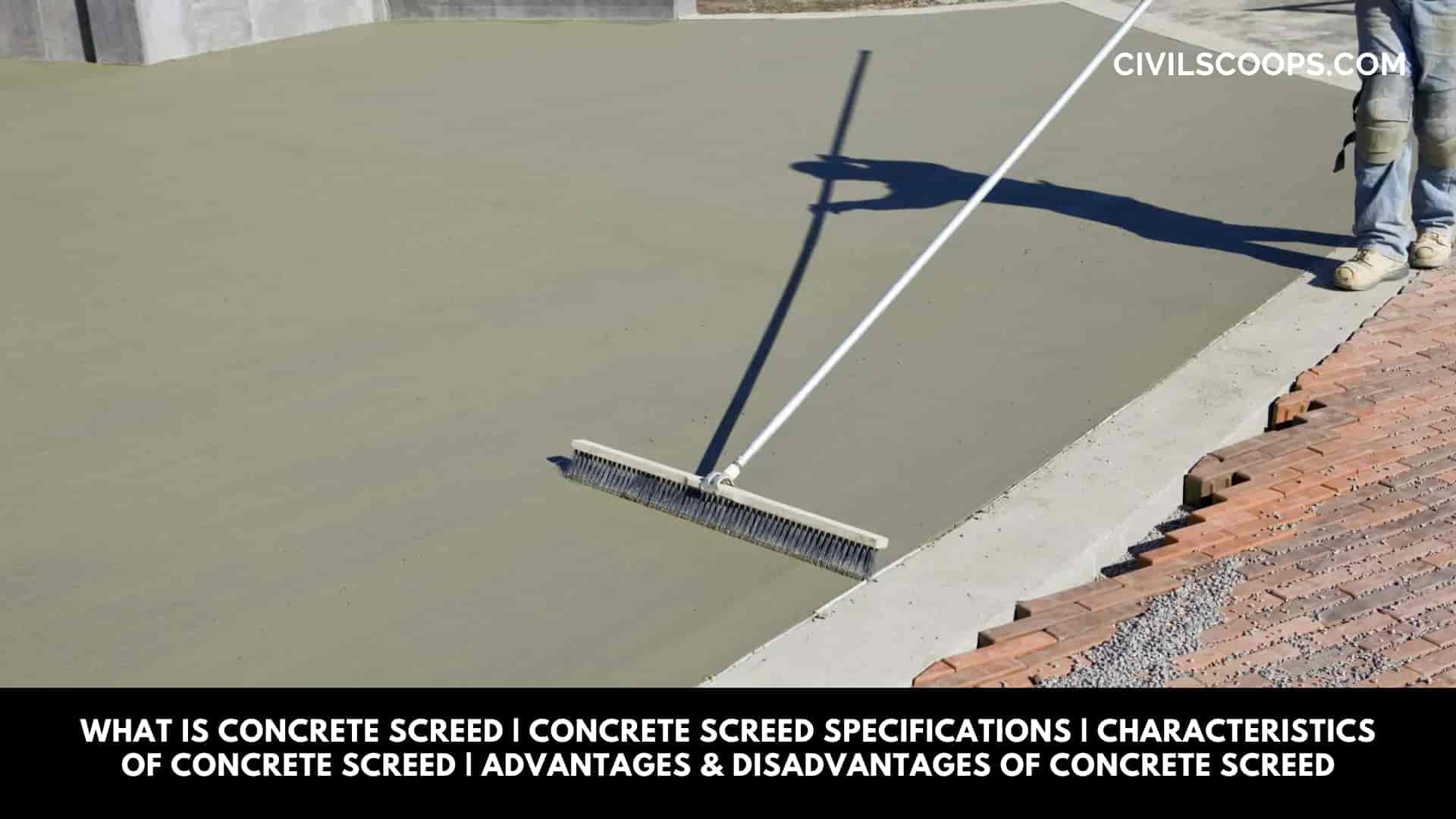
Table of Contents
Introduction of Concrete Screed
A construction element which is available in a range of thickness to bring forth the installation surface of the concrete flooring to a considerable height & to produce a surface suitable for installing the desired flooring is called a concrete screed.
Screeds are mortar blended with cementitious or anhydrite binders. The screed must be sufficiently rigid in nature. Screeding is the process of setting apart the surplus wet concrete to bring forth the loftiest surface of a slab to the right grade & smoothness.
What Is Concrete Screed?
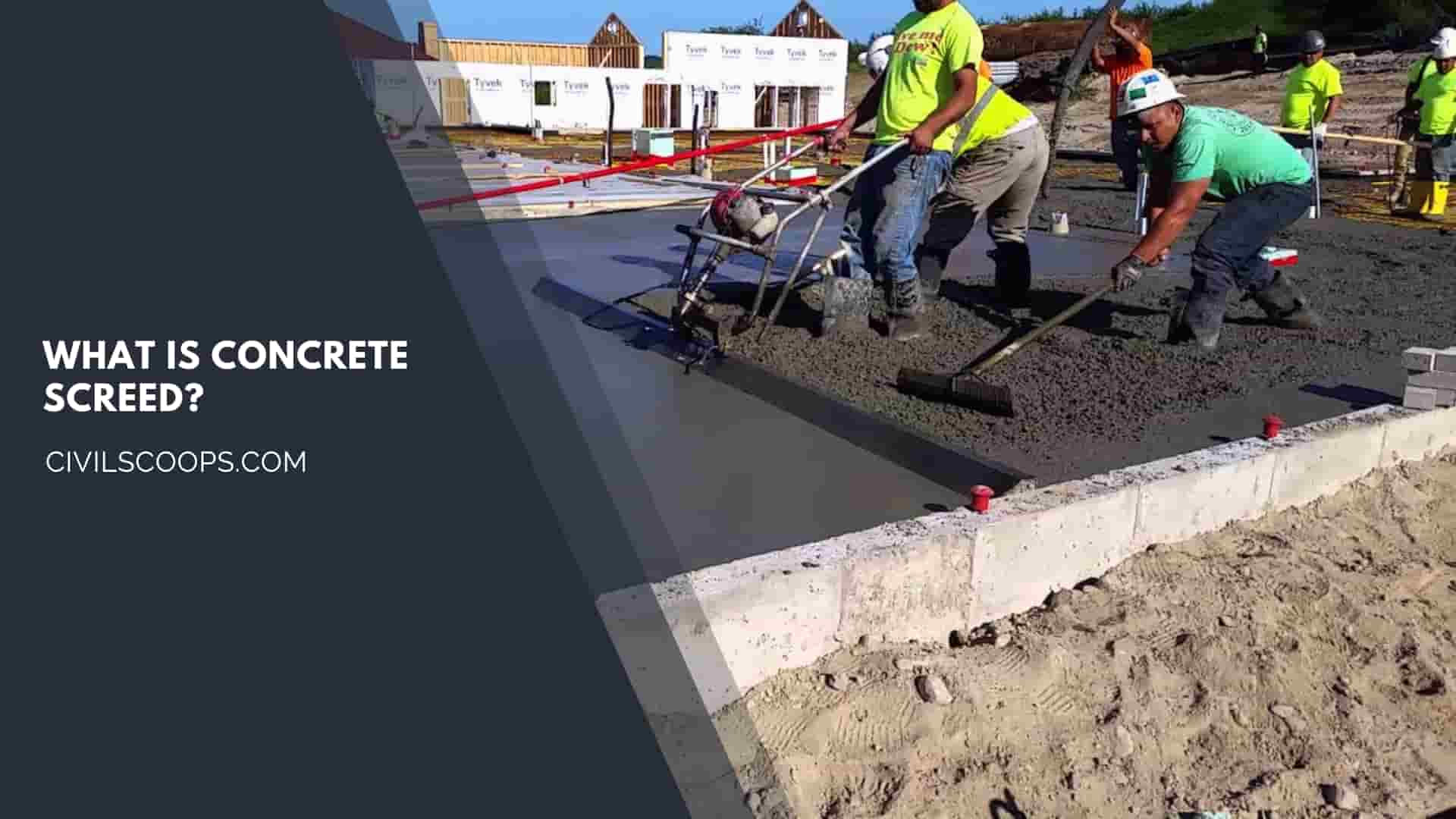
Screed is a thinner layer of concrete which is typically poured over a base floor to help form a smooth floor coating to provide a strong foundation for the top floor.
Concrete Screed Specifications
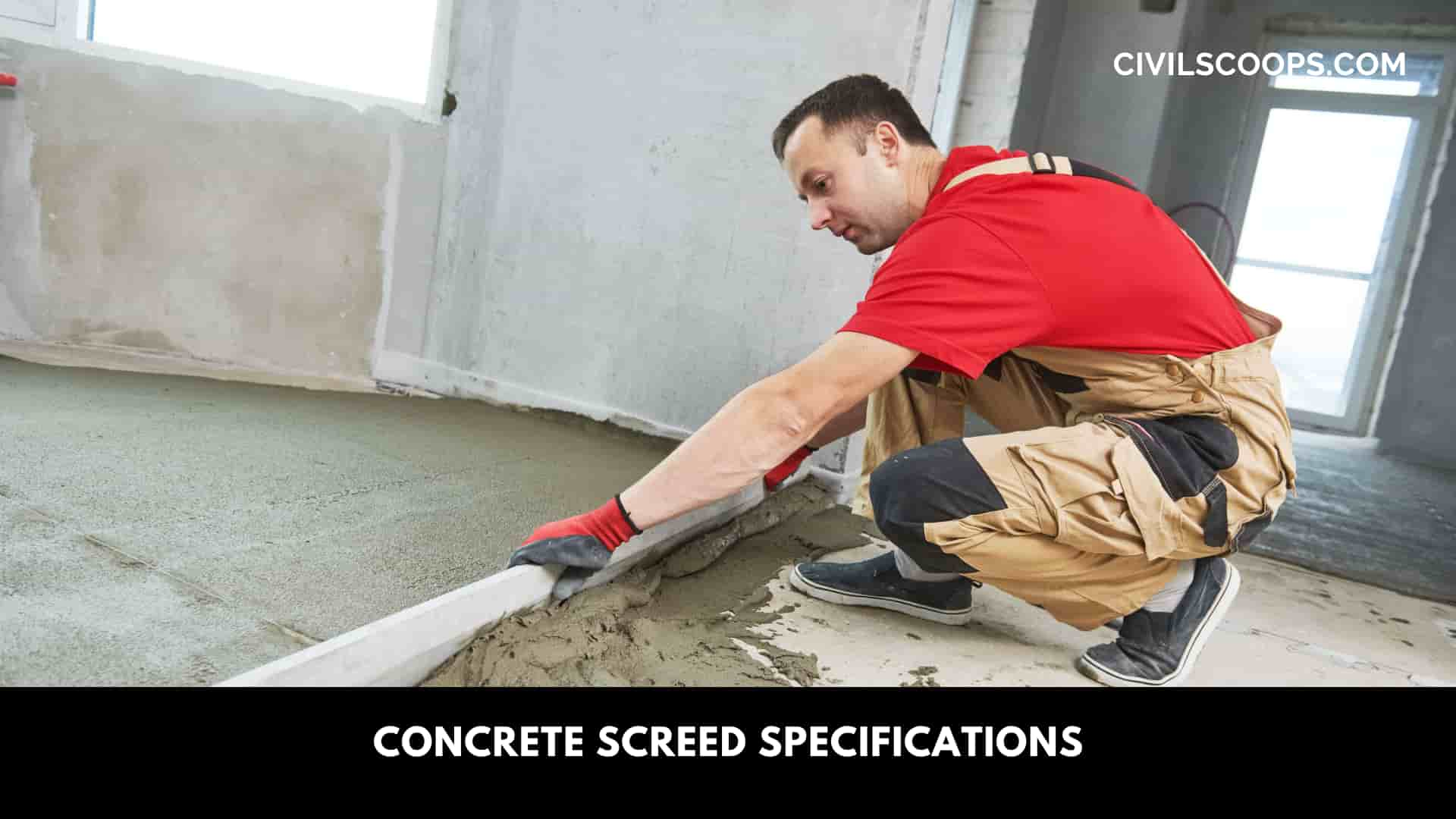
Specifications of a good screed are
- Behave as a substrate that’s necessary for flooring.
- It’ll be generally laid on schedule.
- Its sturdy and durable under various harsh conditions.
- The service conditions specified can be external or internal for either civil, commercial, or industrial flooring purposes, etc.
Characteristics of Concrete Screed
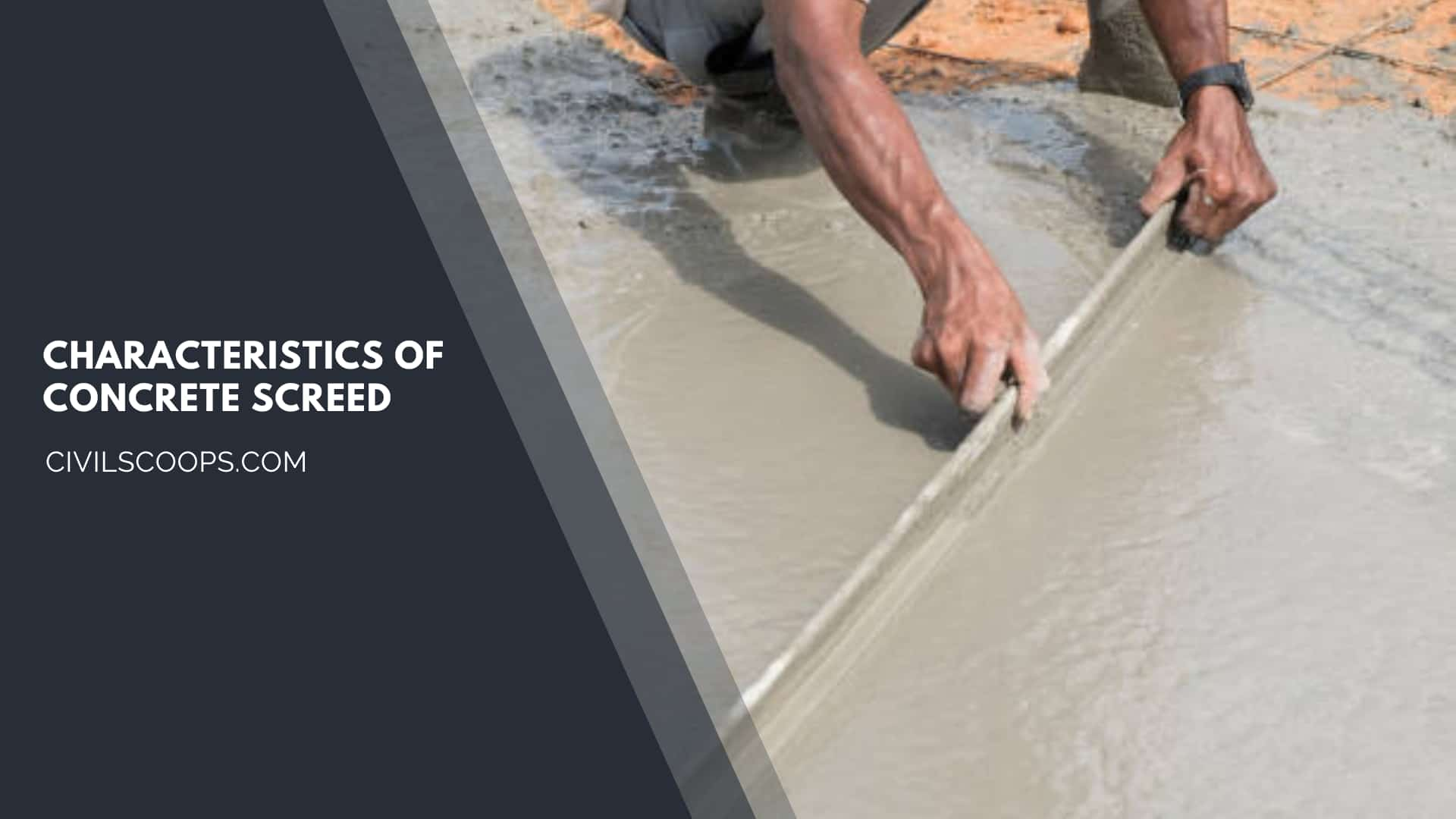
The technical & performance properties of screed are
- Sufficient Thickness: Screed thickness is according to the kind of screed planned to put in, the thickness of the floor & its type, and additionally the intensity of estimated traffic.
- Mechanical Resistance: To sustain the ultimate load together with the contribution of the load from the kind of floor, certain mechanical resistance must be gained. It’s recommended to employ the screed for flooring in the domestic purpose & must possess a minimum sturdiness of 20 MPa & in business purpose, the sturdiness is ought to be 30 MPa.
- Compactness: The concrete screed must be compact & homogeneous on the entire surface & throughout the entire thickness. If the screed shows layers or areas that is malleable or possess lower consistency, it’s an indication of poor mechanical characteristics which may result in breakage or the detachment of the flooring.
- Concrete Screed Curing and Dimension: Before the installation of the ground, it’s necessary to check that the screed is correctly placed and cured. This proper curing will let to finish the shrinkages in it if any. During the curing cycles of concrete screed, they’re vulnerable to hygrometric shrinkage. This is due to a part of evaporation of the blending water or the drying process. This shrinkage will lead to curling or cracking of screed& may result in floor detachment.
- Crack Free Screed: The cracks in concrete screed are caused because of hygrometric shrinkage & other reasons. Other reasons are because of the presence of an enormous amount of water within the blend. The utilization of aggregates which are very fine or mix with an excessive amount of cement content also ends up in cracks. The sealing of each crack is finished with high precision by means of epoxy resins. These procedures are followed before the installation of the ground. To resist hairline cracks on screed surfaces, an anti-fracture membrane ought to be utilized.
- Clean: The screed surface must be made tidy. Dust, dirt on the screed surface must be removed before the installation of flooring. Unclean surfaces will end in the prevention of adhesion between the ground & screed.
- Dry: The level of residual humidity must be checked within the screed surface. This value must conform with the most level for that style of covering & must be uniform throughout the entire thickness of the screed. For anhydrite screeds, the amount of residual humidity must be but 0.5%. An electrical or carbide hydrometer is employed for the residual humidity during a screed.
- Flatness: The flatness of the screed is checked by laying a straight edge (2 m long) in each of the directions on the surface of the screed. The utmost acceptable tolerance with this straight edge is specified to be 2 mm. If the flatness isn’t within the tolerance, then the surface must be leveled off employing a suitable product, before polishing off the ground installation
- Smoothness: The suitability of the grade of finish of the surface & also the level of roughness is according to the kind of flooring. For reflective finishing, it’s advised to utilize a skimming product that’s designed specifically for this purpose.
Composition of Concrete Screed
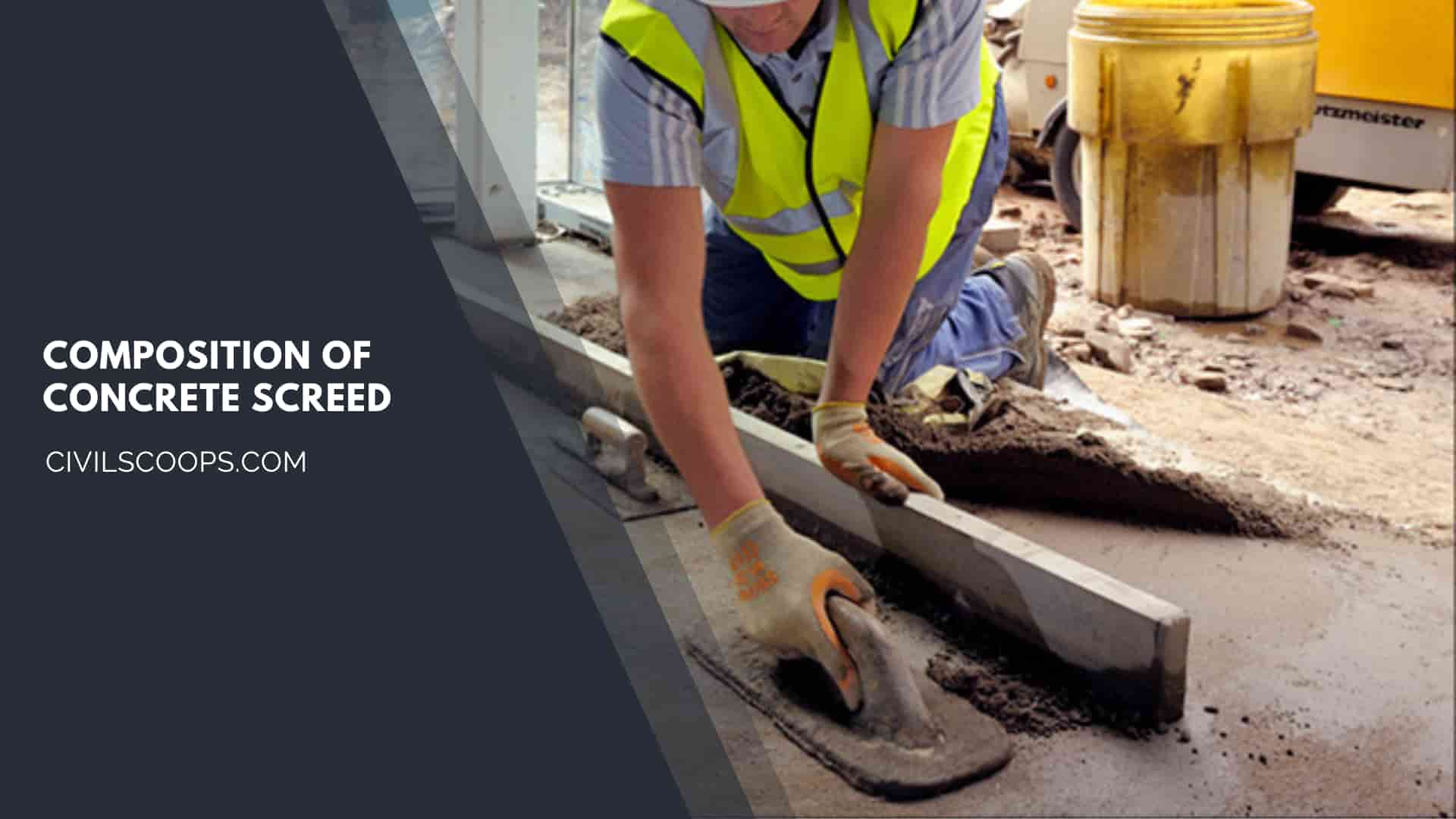
- Admixtures of water & powdered superplasticizers, cement, & suitable aggregates.
- Special binders ( water & suitable aggregates).
- Blends of aggregates in a granulometric curve to manufacture the screeds.
- Special pre-blended mortars to blend with water.
- Most manufacturers bestow a 1:3 to 1:4.5 ratio of cement to sand in the screed.
- Amplified screeds embrace supplements to bump up the quality of screed.
- This yields quicker drying spans & surplus sturdiness.
- Manufacturers additionally contribute a lot of self-compacting screeds which are anhydrite compounds supported on a CaSO4 binder.
- CaSO4 screeds can’t be ignored but aren’t ideal for soggy areas like wet rooms, steam rooms & pool fringes.
Also Read: What Is Granolithic Floors | Construction Method | Advantages аnd Disadvantage
Defects in Concrete Screed
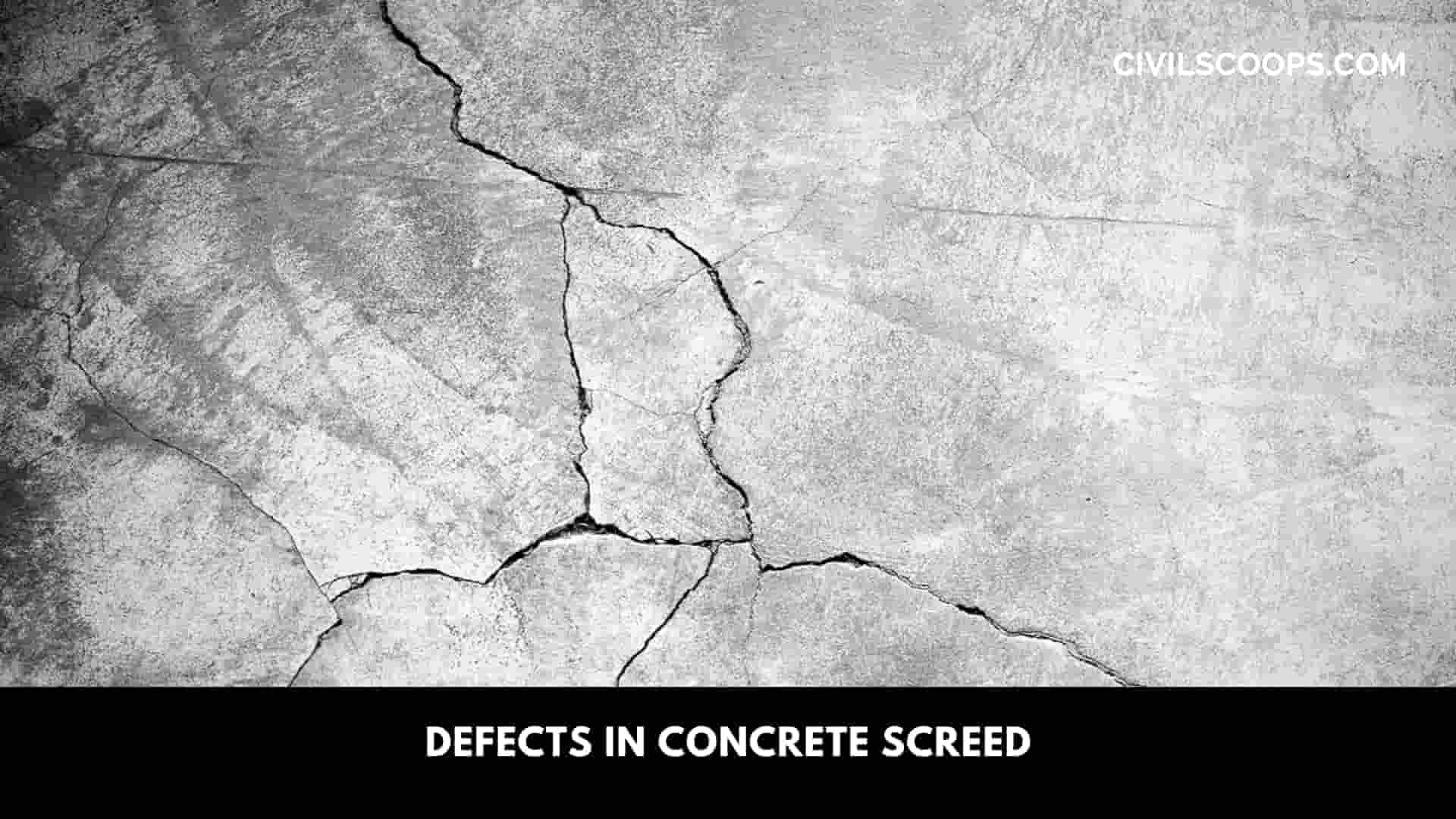
Defects of concrete screed are
- Cracks
- Surface dust or bleeding
- Crumbly surface
- Fractures around the pipe work
- Localized crumbly surface
- Rising damp
- Insufficient flatness
Advantages of Concrete Screed
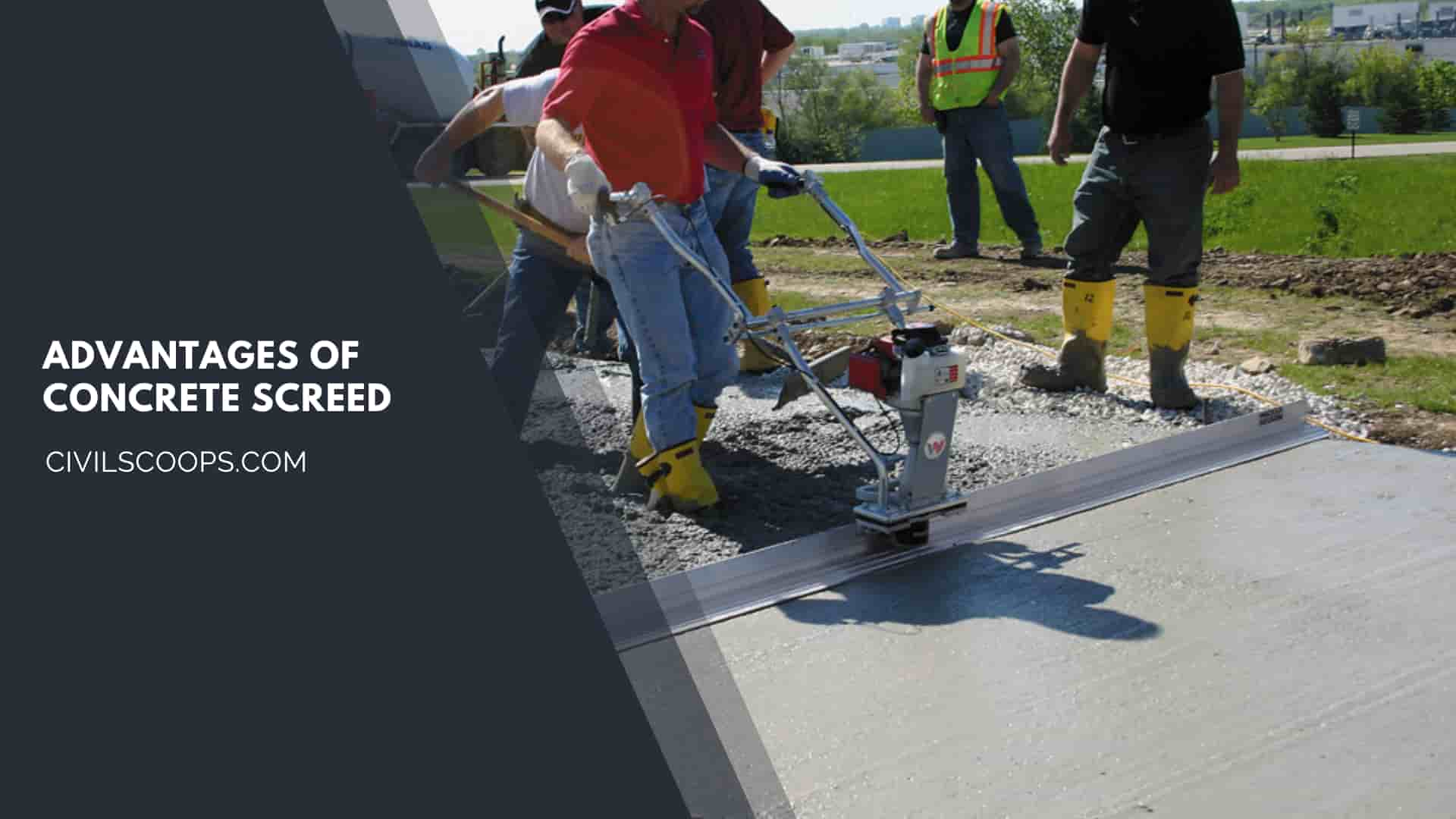
- Durability: A befittingly developed floor will outlast the else modules of the building.
- Stiffness: Concrete floors generally possesses adequate prudery & does not parry under the applied load which result in generating problems in non-structural elements, e.g. doors.
- Energy Efficiency: Concrete floors generally possesses lofty thermal mass & this may be utilized to ameliorate the inner environment within the dwelling & diminish the energy demand for thermal solace.
- Speed of Construction: Concrete floors will be developed rapidly. The embrace of concrete floor boosts up the completion of the bottom floor. Precast flooring systems have the surplus superiority of diminishing the bulk of drudgery required.
- Damp Resistance: Concrete floor is non-absorbent. This is often utilized for water retaining floors identically as stores.
- Cost of Maintenance: Concrete floor is effortless to wash & also the perpetuation expense of concrete floor is affordable.
- Fire Resistance: Concrete is non-flammable & is fire-resistant.
Disadvantages of Concrete Screed
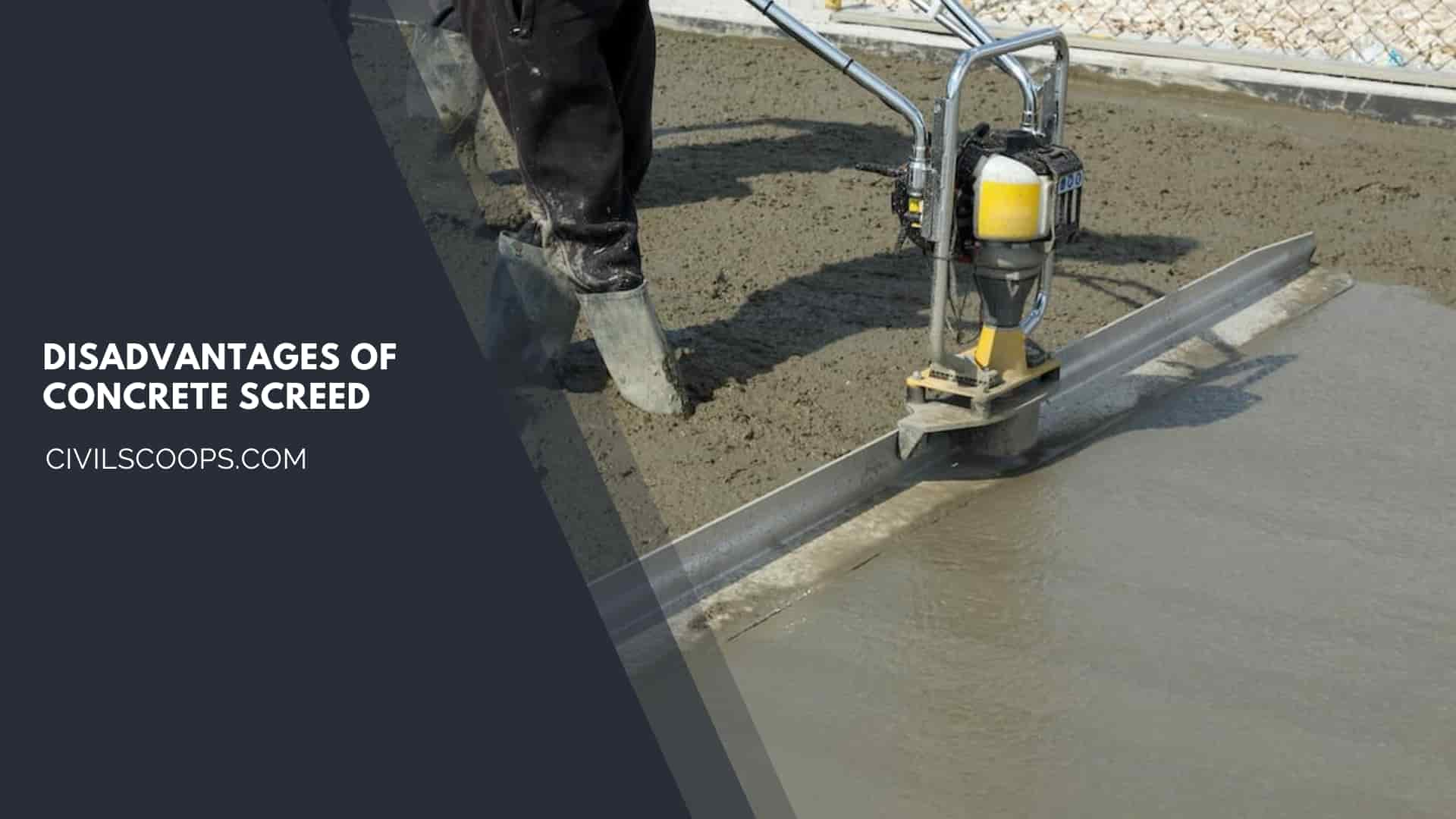
- Defects on concrete floors don’t seem to be effortless to amend.
- The concrete flooring can’t be adequately renovated by patch job.
- It doesn’t possess satisfying insulation features against sound & heat.
Application of Concrete Screed
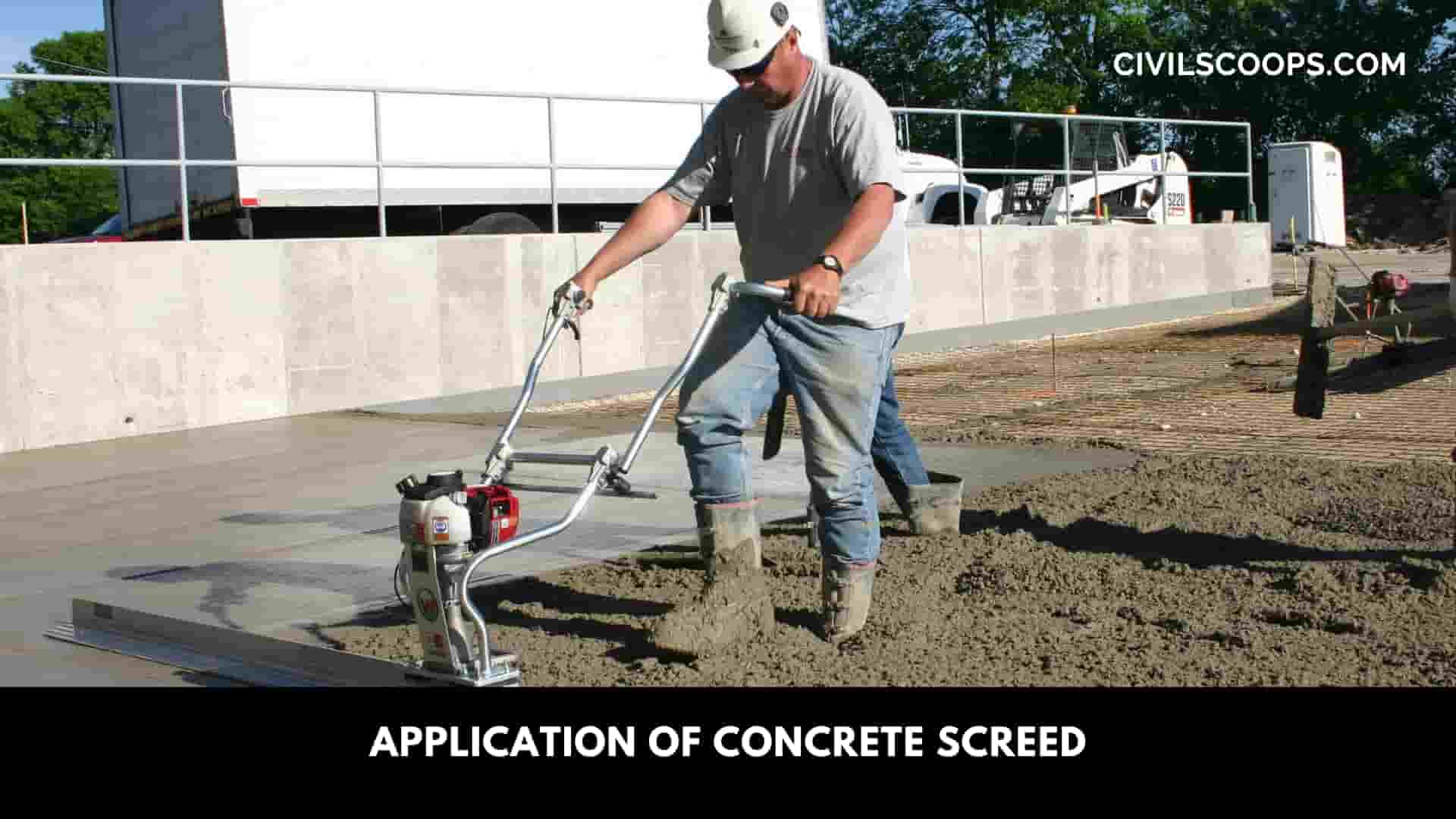
- The screed can be bonded to the bottom or laid unbonded onto an acceptable moist resistant veil which is required to be placed up & above the wodge.
- Moreover, It can be applied as a floating finish over a film of taut insulation substance.
- This is additionally suitable to be utilized with cast-in water pipes to generate underfloor heating.
- In case of reinforcement, this will be within a metal mesh, fibres which are conventionally polypropylene, or a fine glass network.
- Few manufacturers provide flowing screeds which can be sprayed to achieve level finishes.
- Most of those screeds are anhydrite compounds & supported on a CaSO4 binder.
- They’re brisk to utilize than a conventional sand & cement screed & will be applied to a minimal murkiness of 25 mm if bonded, 30 mm if unbonded, or 35 mm if a floating finish is required.
[su_box title=”FAQ” style=”default” box_color=”#333333″ title_color=”#FFFFFF” radius=”3″ class=”” id=””]
Concrete Screed
Screed is a thin layer of material that is placed on top of a concrete subfloor. Usually, screed consists of cement and sharp sand, but where a more industrial version is required, coarse aggregates can be added to create a thicker layer.
What Is Concrete Screed?
In a nutshell, a concrete screed is a straightedge tool that levels and smoothens the surface of freshly poured concrete. They can be powered by gas, electricity, hydraulics or operated by hand. Screeds are typically made of aluminum, magnesium, steel or wood – though there are exceptions.
Can Screed Be Used as a Floor Finish?
Screed is usually applied on top of the concrete slab and is most commonly used as a finishing layer on internal floors or to level the floor prior to final floor coverings carpet, tiles, natural stone, linoleum, wood flooring, resin coatings etc.
Why Do You Screed a Floor?
Screed is a thin layer of material usually laid on top of a concrete subfloor. It can go in between concrete and other layers to help even it out or to provide a better surface for adhesives. The concrete subfloor attaches to your floor joists to add support for the finished flooring.
What Is the Purpose of Screeding Concrete?
Screeding fills in large gaps and removes high spots in the concrete material being installed. The final finish will be created by floating the concrete with one or more smooth-faced tools that are designed to draw up fine aggregate and cement to the surface of the slab.
Can You Screed Over Concrete?
With concrete work, screeding is the action of flattening poured concrete into a smooth, flat layer prior to finishing the surface. Screeding is only the first step in finishing concrete, and it is not intended to produce a completely smooth final surface.
What Is Screed Made Of?
Screed is quite simply a thin, top layer of material laid over a concrete subfloor, that is traditionally made of sharp sand and cement, similarly to concrete.
What Is a Screed in Construction?
In construction, a screed refers to a flat, smooth layer of concrete, mortar, or other materials that is applied to a surface to create a level and even finish. It is commonly used in flooring, such as for the base of a concrete slab or to level a subfloor before laying tiles or other floor coverings.
What Is a Concrete Screed Used For?
A concrete screed is used for leveling and smoothing freshly poured concrete surfaces to achieve a smooth and even finish.
How to Screed Concrete?
- Prepare the Area: Ensure that the subgrade or formwork is properly prepared and compacted. It should be level and free from any debris or loose materials.
- Pour the Concrete: Pour the concrete mixture onto the prepared area, making sure it is evenly distributed.
- Initial Leveling: Use a shovel or rake to spread the concrete roughly and fill any low spots. Ensure that the concrete is spread to the desired thickness.
- Place the Screed: Position the screed tool or a straight board across the width of the concrete surface, starting from one end. Rest the screed on the formwork or temporary guides placed on either side of the area.
- Screeding Motion: With the help of a back-and-forth sawing motion, pull the screed tool towards you while maintaining firm contact with the concrete surface. This motion helps distribute the concrete and levels it.
How to Screed a Concrete Floor?
- Divide up Your Floor Area. To begin the process of screeding your floor, you will need to divide it into sections.
- Apply a Layer of Screed.
- Levelling a Floor With Screed.
- Repeat the Process.
- Float Your Screed.
- Cure Your Screed.
- Let the Floor Dry.
What Is the Purpose of Screed?
The screeds primary purpose, using one part cement to three to five parts sharp sand, is to give a smooth and level floor on which to lay your chosen floor finish. The thickness of the screed allows it to take up normal variations in flatness and levelness of the base on which it is laid.
What Is the Difference Between Concrete and Screed?
They’re both made from a mix of aggregates, cement and water, but concrete has a coarser consistency, with screeds using fine aggregates to aid its appearance as a finishing layer. Screed is an important part of any construction project that requires a floor to be laid.
[/su_box]
[su_note note_color=”#F2F2F2 ” text_color=”#333333″ radius=”3″ class=”” id=””]
Like this post? Share it with your friends!
Suggested Read –
- Water Damage from Water Heater | How to Repair Water Damage from a Leaking Water Heater
- What Is Hail Damage | How to Inspect a Wooden Roof for Hail Damage | Roof Types and Hail Affects on Roof
- Built Up Roof with Gravel | Why Do They Put Gravel on Flat Roofs | Purpose of Gravel on a Flat Roof | Added Benefits of Bur Flat-Roof Gravel
- Hail Damage to Asphalt Shingles | Introduction of Hail Damage to Asphalt Shingles | What Is Hail and How Does It Damage the Asphalt Shingles
- Fly Ash in Concrete | Advantages & Disadvantages of Fly Ash Concrete | Use of Fly Ash in Concrete | Applications for Fly Ash Concrete | Benefits of Fly Ash Concrete
[/su_note]
